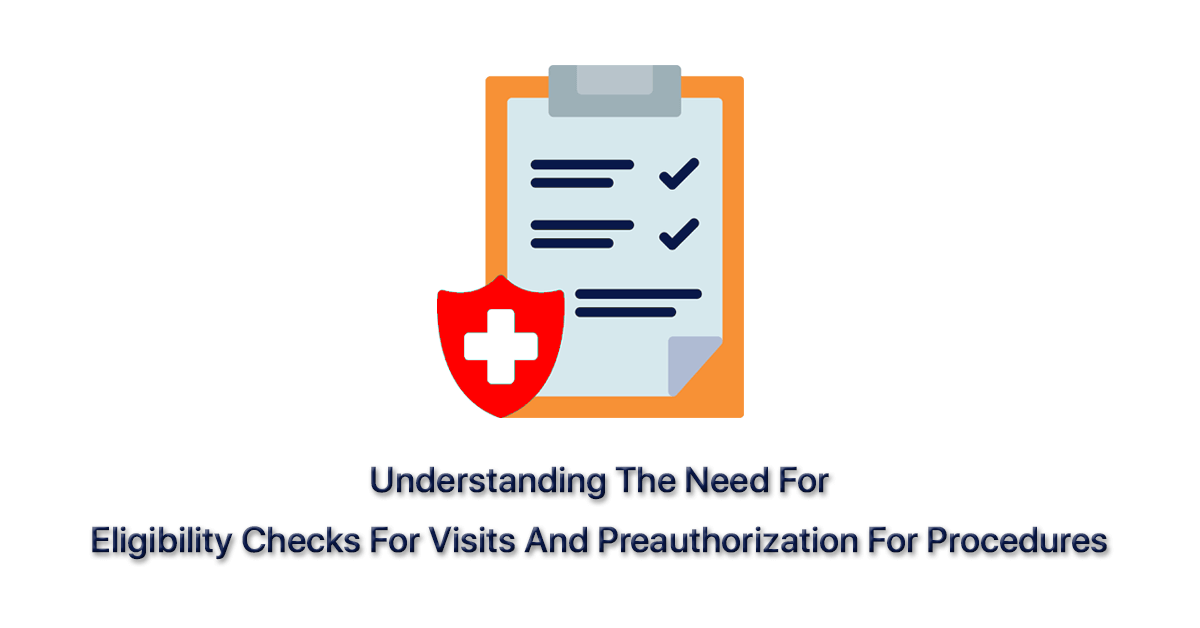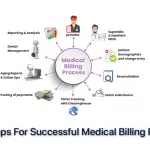While these activities oftentimes become challenging, they should help in facilitating reimbursement.
This month, we’ll dive into the next steps needed for medical practices to take after being credentialed to maximize the chances of receiving reimbursement. The next critical steps after getting credentialed are (1) to conduct eligibility checks for patient visits and (2) get preauthorization for procedures.
Why These Steps Are Important
One scenario where an eligibility check becomes useful is when a patient has an inactive or termed insurance. An eligibly check would help the front desk to ask the patient for alternative active insurance prior to the appointment. This quickly improves patient collection.
Likewise, eligibility checks help to identify those patients with high deductible plans. This helps anticipate a patient’s co-insurance and co-pay. When the co-pay is identified it can be collected upfront, rather than chasing the patient for payment afterwards (which is time consuming and inefficient).
But verifying eligibility and obtaining preauthorization can be challenging for healthcare practices for many reasons:
- They are time-consuming: Checking eligibility and obtaining preauthorization requires significant staff time and resources. The average time for clinic staff to conduct insurance eligibility checks or procedure preauthorization varies depending on the complexity of the insurance plan, the experience of the staff, the technology used, and the volume of patients. Generally, to complete the eligibility verification process, it can take anywhere from a few minutes to an hour or more. The preauthorization process takes even longer. On average, getting preauthorization can take anywhere from a few days to several weeks. Preauthorization requirements can be complex and time-consuming, and they may require multiple follow-up calls and documentation submissions.
- Staff resources: Some practices may have difficulty allocating sufficient staff time and resources to these tasks, especially in busy or understaffed clinics.
- Payer inconsistencies: Different insurance companies and payers have varying requirements for eligibility checks and preauthorization, which can make the process confusing and difficult to navigate for healthcare practices.
- Lack of payer transparency: It can be challenging for practices to receive clear and accurate information from insurance companies and payers regarding the status of their eligibility checks and preauthorization requests.
- Outdated office technology: An insufficient technology infrastructure can make it difficult for practices to obtain eligibility checks and preauthorization efficiently and effectively.
Specialty practices, such as cardiology for example, may face even more hurdles in obtaining preauthorization, including providing additional documentation by the specific specialty.
Even though getting verification of a patient’s insurance eligibility and obtaining preauthorization prior to rendering services is burdensome and time-consuming, these steps are essential to ensuring predictable and timely reimbursement.
To expedite reimbursement, we must educate healthcare practices of the value to their practice of taking these steps by showing them the downside of not doing so.
- Patient dissatisfaction: A patient who arrives to the clinic expecting to receive treatment, only to be told their eligibility or preauthorization has not come through will lead to,
- lack of timely treatment
- non-compliance
- embarrassment of the patient
- potential anger at the front office staff
- Denied claims: If a patient is seen by the provider, but the patient’s insurance eligibility and/or preauthorization have not been obtained, the practice may be unable to receive payment for services rendered, leading to denied claims and a decrease in expected revenue.
- Delayed payments: If a claim is denied, the practice may need to resubmit the claim, which can result in delayed payments and disruptions to the revenue cycle.
- Increased administrative burden: The practice will need to spend additional time and resources to resolve denied claims and ensure that payments are received, which can increase the administrative burden on the practice.
- Revenue losses: If a patient’s insurance coverage and preauthorization requirements are not fully understood, the patient may be asked to pay out-of-pocket for services they believed were covered, leading to decreased patient satisfaction and likelihood of revenue losses due to non-collection.
- Increased risk of audits: Incomplete or inaccurate documentation, including failure to check a patient’s insurance eligibility and obtain preauthorization, can increase the risk of audits, which can result in fines and decreased revenue.
- Reduced capacity for patient care: If the practice is not able to effectively manage its revenue cycle, it may be forced to reduce its capacity for patient care, which can have a negative impact on patient outcomes and satisfaction.
To help medical practices head-off these issues, we need to advocate to medical practices the importance of building into their office policies a streamlined method for checking a patient’s insurance eligibility and obtaining preauthorization prior to rendering services. This way, medical practices can minimize these disruptions and ensure that their revenue cycle runs smoothly. But making these kinds of changes to regular office policies will take time.
To shorten the time, follow the management practices:
- Use technology-service solutions: newer technologies offering automation of eligibility checks and prior authorization approvals have considerable benefits: reducing manual tasks; identifying in advance termed insurance and high deductible plans; anticipating a patient’s co-insurance; and identifying co-pays, so collection can be made at the time of the appointment. Automation technologies cut costs and boost speed. Unfortunately, not all automation is created equal. Technologies that specialize in automating these RCM tasks, and do it effectively, empower the clinic and billing teams to stay on top of volume and reduce avoidable write-offs. When your system effectively initiates, statuses, and logs authorizations, you should see results. Do your research when selecting automation and it can pay off. Optimally, providers should see a 50 percent improvement in productivity and a reduction of up to 54 percent in avoidable write-offs.
- Make sure you have adequate staff and provide continued training and support
- Work closely with payors to streamline the eligibility and preauthorization process
For More Information: understanding the need for eligibility checks for visits and preauthorization for procedures



